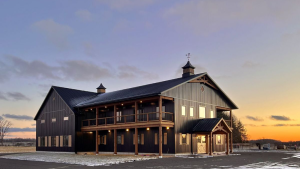With the increasing number of fires occurring in farm buildings, insurance companies are urging constructors to consider resilient design.
“What we would like to do as a group of insurance companies, we would like to have some say in how buildings are built,” said Randy Drysdale, assistant vice-president of loss control and technical development for Farm Mutual Reinsurance, during a presentation at the Canadian Farm Builders Association’s annual conference held recently in Stratford, Ont.
“What we would like to see is resilient design incorporated when a structure is rebuilt. What happens is quite often they are built back almost to the exact same style. If it burned once, what is preventing it from burning again, or what is preventing it from falling down again? If we can increase resilience at the post-disaster reconstruction, we can have an effect on how the buildings are going to survive into the future.”
He said there are a number of areas where things can be improved.
“We want to look at ways we can make barns safer, look at different things we can do when they are built or when they are being fixed after a loss, even if it’s a partial loss or if they are just going to reconstruct a portion of the barn,” explained Drysdale, adding farmers, associations, officials and insurance companies need to work together to minimize damage and loss.
“You (builders) should be thinking ‘what can I do that can affect the ability of the structure during the planning stage?’ We’ve gone out to some of the large structures when they are in the construction phase and we’ve talked to farmers about putting in fire separation walls and or fire doors. If you have a $6 million structure and you are spending $10,000 to $20,000 putting in a fire door it shouldn’t be that much of an issue, but we are getting a lot of push back.”
Things to consider include compartmentalization, fire-rated assemblies, fire stops, fire dampers, sprinklers and control devices inside the barns.
“Really the barns are built to burn. They are organized kindling,” Drysdale stated. “There are combustible materials, wood frame, unprotected structures, generally too far away from fire halls to have the fire department make a big difference.”
It’s not just fires, Drysdale pointed out. Extreme weather such as rain, snow and wind also cause damage that can start fires or destroy barns.
“We want to look at ways that we can enhance the ability for a structure to survive losses,” said Drysdale.
“We understand that you can’t change things overnight but we would like to see small incremental steps in how buildings are built so we can start to say to our reinsurers we are making a change on these structures.
“A lot of the mutual companies are really investing in loss prevention because of the number of losses that we are having.”
As an example, he spoke about a large potato barn fire that resulted in a $9-million loss, with most of the damage caused in about an hour. The farmer made substantial changes in designing the new building.
“The policy holder spent a substantial amount of money to go over and above the needs of the building code,” explained Drysdale.
“I know it’s going to add to the cost of the building but eventually you have to look and say farm buildings have the potential to burn and could maybe become uninsurable in the future. I’m not saying they are going to be but if there are enough fires it starts getting to the point where it is too expensive to buy insurance. Our reinsurance costs are going up on a yearly basis and they are going up by a substantial amount.”
The policy holder for the potato barn incorporated many resilient elements into the design of the new facility.
“When he rebuilt, the farmer put fire doors throughout the entire building, he did a fireproof room for the battery charged equipment, he put up tilt-up concrete panels, he’s got a 30-foot ceiling there now. He also went with a double truss system and he put hurricane straps on all the trusses,” said Drysdale.
He added there are a few products on the market that may be able to minimize the spread of fire in barns, including a Haven fire suppression safety device.
“It will put out a fire in a building area 16-feet-by-16-feet,” explained Drysdale.
“It sits up in the rafters. What we’re going to start recommending is in all mechanical and electrical rooms of agricultural buildings, we’re going to say they should be installing these. We’re not going to make it mandatory at this point but we’re going to start talking about this and we’re going to promote it. If we can stop that fire in that mechanical room, we can save all the animals, we can save all the buildings, we can save all the losses that occur. There is nobody that makes money on an insurance claim.”
There is also a company that specializes in fire prevention systems which installs extinguishers in the attic connected with controllers that can flood the entire attic with extinguishant.
“That’s the weak point in the barn so that’s another option for the future,” Drysdale noted.
“There is also a sprinkler system that goes into a heated little room. It’s about the cost of a generator and you can flood the entire building with a soap and water solution right to the rafters.”











Excellent start! Promoting sprinkler and other automatic suppression systems is the way to proceed. All the suppression action will be underway long before the fire is even noticed or the department is dispatched, saving hundreds-to-thousands of lives. I’m a firm believer that sprinkler systems should be installed in every structure occupied by oxygen-breathing beings; this is one step towards that goal.